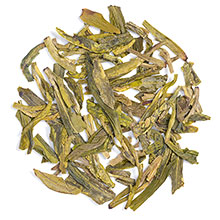The Complete Guide to Dragonwell Tea
by Abby Morrison
June 02, 2020

What is it?
Dragonwell tea (also known as Lung Ching or Long Jing tea) is a popular green tea originating from Hangzhou in the Zhejiang province of China. It is characterized by its unique flattened leaf shape, which is achieved by pressing the leaves against the side of a hot wok to stop the oxidization process, and the toasty flavor that the pan-firing process gives to the tea.For our Dragonwell tea, we have a few different varieties. First, we have two Masters Teas. Shi Feng Long Jing, or "Lion's Peak Dragonwell" hails from the West Lake region of Hangzhou and is one of China's most famous teas. It's got a lighter, more delicate flavor than other Dragonwell teas, with some sweeter tones. Da Fo Long Jing or "Big Buddha Dragonwell" is grown in Eastern Zhejiang, near the temple for which it is named. It is characterized by nutty and floral notes.
Our third kind of Dragonwell is on our Adagio site, and is actually part of our Roots Campaign, where we highlight the local farmers from around the world to bring you not only the best teas, but also the stories of the people who grow them. For example, we have an interview with our Dragonwell farmer, Yao Fu Yun, here, where you can learn more about what challenges, joys, and processes go into making your favorite cup. We also send postcards with every order of Dragonwell that you can send directly to the farmer to thank him and encourage him for his hard work. It's really neat.
Preparation and taste

As a green tea, Dragonwell should be steeped at a lower temperature than black tea, about 170-180°F, for 2-3 minutes, depending on the tea. As always, make sure to check the instructions for your specific tea to keep it from over-steeping or burning. As with all teas, if you want a stronger flavor, simply adjust the number of tea leaves you use, not the temperature or steep time. Yao Fu Yun gives some good tips for Dragonwell preparation in his interview. When preparing it myself, I also noticed that it might help to prepare the tea in a bigger infuser, such as the infusing basket in our VelociTEA Kettle, Adagio tea Travel Tumblers, or even one of our teapots, which come in glass, Yixing (Chinese clay that absorbs the teas' flavors), cast iron, and glazed iron varieties. This lets the tea leaves expand more and have water on a greater surface area than you might get from a tea ball or bag.
For flavor, that is going to vary by the type of Dragonwell, with anything from altitude to picking time to soil minerals. As mentioned above, our two Masters Teas are both on the lighter side, with one leaning more to the sweeter, fruity side, and one more to the floral side, with nuttiness being the mutual flavor connecting them both. Our standard Dragonwell, however, has a more buttery flavor. Adagio's fine Dragonwell green tea also has a sweet, rounded flavor, perhaps reminiscent of freshly roasted white corn. Full, nutty and buttery texture, and pleasantly dry finish. And if you think having tea that tastes like corn with a buttery texture is weird, trust me, it's delicious. It is less mineral-y or crisp than other green teas, and you really can taste that thickness in the mouthfeel, despite it having the same viscosity as any other tea.
Like other green teas, Dragonwell should not be paired with milk, lemon, sugar, or other sweeteners.
Flavor pairings
Because of its nuttiness, Dragonwell goes well with more savory or umami flavors than it will with sour or sweet flavors, though the nuttiness can be paired with sweet as well. It works well as a drinking tea if you're looking for something rich and comforting (think snuggling in for a long fall evening), but not as well for something refreshing or cleansing, or for a dessert tea.Long used in Chinese cooking, it can be used as a way to flavor sauces or broths, as well as an ingredient just as a leaf. For example, crush the leaves and you can use them as a seasoning or spice. Or use the larger leaves as additions to salads or stir fry. Doing a quick Google search on Dragonwell recipes will instantly pull up a ton of recipes to use it with shrimp, too.
Recipes
A couple of recipes from our TeaChef site that feature Dragonwell include:Dragonwell noodles
Apple Muffins with Dragonwell Glaze
Another recipe that I suspect would go great with Dragonwell? Hurricane Furikake popcorn from Annelies Zijderveld's tea cookbook, Steeped. Hurricane Furikake popcorn combines popcorn with a Japanese seasoning blend, and her twist on it puts tea in the mix. With our Dragonwell's buttery corn flavor seems like it would be a good fit. Oh, and the book is super cute, so I recommend checking it out if you've got the chance.
So, now that you know all about this wonderful tea, its time to take the leap! Try any of our three Dragonwell teas, and let us know what you think. Rate and review them or share them on social (@adagioteas) to earn rewards points towards your next purchases, and if you come up with the next great Dragonwell recipe, make sure to share it on TeaChef to earn even more points. Oh, and if anyone tries that popcorn recipe, let us know! Enjoy!